136 scholarly books by Dartmouth College Press and 9
have author last names that start with M
136 scholarly books by Dartmouth College Press and 9
136 scholarly books by Dartmouth College Press
9 have author last names that start with M have author last names that start with M
9 have author last names that start with M have author last names that start with M

Relocating Eden
The Image and Politics of Inuit Exile in the Canadian Arctic
Alan Rudolph Marcus
Dartmouth College Press, 1995
In the early 1950s, a number of Inuit men, women, and children were loaded on ships and sent to live in the cold and barren lands of the Canadian High Arctic. Spurred by government agents’ promises of plentiful game, virgin land, and a lifestyle untainted by Western Influences, these “voluntary migrants,” who soon numbered nearly ninety, found instead isolation, hunting limited by game preserve regulations, three months of total darkness each winter, and a government suddenly deaf to their pleas to return home. The question, still unresolved forty years later, is whether these “experiments” were a well-intentioned governmental attempt to protect the Inuit way of life or a ploy to lure innocent people to exile, hunger, and deprivation in order to solidify Canada’s Cold War sovereignty in the far North. Alan Rudolph Marcus outlines the motives behind the relocation, case histories of two settlements, and the aftermath of the migration. Relocating Eden provides a timely and provocative inquiry into issues of continuing importance to Canada and all native peoples.
[more]
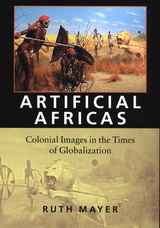
Artificial Africas
Colonial Images in the Times of Globalization
Ruth Mayer
Dartmouth College Press, 2002
“Africa is an artificial entity,” notes Ruth Mayer, “invented and conceived by colonialism.” In this wide-ranging study, Mayer explores the ways in which Western, and especially American, popular culture has manufactured and deployed various images of “Africa,” and how those changing constructions have reflected Western social and political concerns from the era of colonialism to the age of globalization. Mayer mines an enormous array of sources to expose the diverse images and narrative strategies that have been prominent in Western representations of Africa. She ranges authoritatively from King Solomon’s Mines and Tarzan to Khartoum and Greystoke, from Conrad’s Heart of Darkness to Nicholas Roeg’s film version, from Isak Dinesen and Ernest Hemingway to Ishmael Reed and Charles Johnson, from comic books to hip hop acts. In the process, she shows how seemingly stable cultural stereotypes have actually been transformed to reflect changing attitudes, conditions, and fears in the West, “adjusting the symbolic repertory of yesterday to the conceptual and ideological frameworks of today.” Dividing her work into “African Adventures” and “Alternative Africas,” Mayer not only restores an international context to American cultural history, but also shows the ways in which these images have functioned within both white and African American communities. With a deft command of both cultural source materials and current debates, Mayer explores the complex and powerful roles these “artificial Africas” have played in Western culture.
[more]
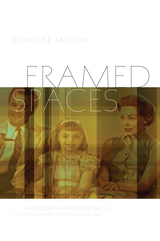
Framed Spaces
Photography and Memory in Contemporary Installation Art
Monica E. McTighe
Dartmouth College Press, 2012
While earlier theorists held up “experience” as the defining character of installation art, few people have had the opportunity to walk through celebrated installation pieces from the past. Instead, installation art of the past is known through archival photographs that limit, define, and frame the experience of the viewer. Monica E. McTighe argues that the rise of photographic–based theories of perception and experience, coupled with the inherent closeness of installation art to the field of photography, had a profound impact on the very nature of installation art, leading to a flood of photography– and film–based installations. With its close readings of specific works, Framed Spaces will appeal to art historians and theorists across a broad spectrum of the visual arts.
[more]
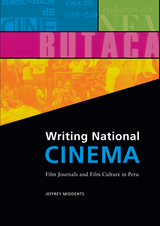
Writing National Cinema
Film Journals and Film Culture in Peru
Jeffrey Middents
Dartmouth College Press, 2009
Writing National Cinema traces the twenty-year history of the Peruvian film journal Hablemos de cine alongside that of Peruvian filmmaking and film culture. Similar to the influential French journal Cahiers du cinéma, Hablemos de cine began with a group of young critics interested in claiming the director’s use of mise-en-scène as the exclusive method of film analysis rather than thematic or star-oriented topics — hence, the title of the publication, derived from their battle cry at post-screening discussions: “Let’s talk about film.” Their critical authority grew with the rise of local filmmaking and the nationalist fervor of the late 1960s and early 1970s. When government sponsorship spurred feature filmmaking in the mid-1970s, their perspective eschewed the politically militant readings that characterized most writing and film from the rest of Latin America at the time. By the 1980s, the critics at Hablemos de cine had helped to engender a commercial, Hollywood-influenced cinematic vision—best exemplified by Peruvian auteur Francisco Lombardi—and stimulated a unique, if isolating, national identity through film. The first book-length study of Peruvian film culture to appear in English, Middents’s work offers thoughtful consideration of the impact of criticism on the visual stylings of a national cinema.
[more]
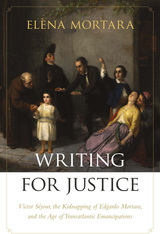
Writing for Justice
Victor Séjour, the Kidnapping of Edgardo Mortara, and the Age of Transatlantic Emancipations
Elèna Mortara
Dartmouth College Press, 2015
In Writing for Justice, Elèna Mortara presents a richly layered study of the cultural and intellectual atmosphere of mid-nineteenth-century Europe and the United States, through close readings of the life and work of Victor Séjour, an expat American Creole from New Orleans living in Paris. In addition to writing The Mulatto, an early story on slavery in Saint-Domingue, Séjour penned La Tireuse de cartes (The Fortune-Teller, 1859), a popular play based on the famed Mortara case. In this historical incident, Pope Pius IX kidnapped Edgardo Mortara, the child of a Jewish family living in the Papal States. The details of the play’s production—and its reception on both sides of the Atlantic—are intertwined with the events of the Italian Risorgimento and of pre–Civil War America. Writing for Justice is full of surprising encounters with French and American writers and historical figures, including Hugo, Hawthorne, Twain, Napoleon III, Garibaldi, and Lincoln. As Elèna Mortara passionately argues, the enormous amount of public attention received by the case reveals an era of underappreciated transatlantic intellectual exchange, in which an African American writer used notions of emancipation in religious as well as racial terms, linking the plight of blacks in America to that of Jews in Europe, and to the larger battles for freedom and nationhood advancing across the continent. This book will appeal both to general readers and to scholars, including historians, literary critics, and specialists in African American studies, Jewish, Catholic, or religious studies, multilingual American literature, francophone literature, theatrical life, nineteenth-century European politics, and cross-cultural encounters.
[more]
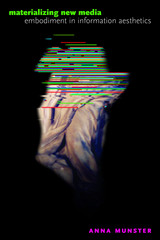
Materializing New Media
Embodiment in Information Aesthetics
Anna Munster
Dartmouth College Press, 2006
In Materializing New Media, Anna Munster offers an alternative aesthetic genealogy for digital culture. Eschewing the prevailing Cartesian aesthetic that aligns the digital with the disembodied, the formless, and the placeless, Munster seeks to “materialize” digital culture by demonstrating that its aesthetics have reconfigured bodily experience and reconceived materiality. Her topics range from artistic experiments in body-computer interfaces to the impact that corporeal interaction and geopolitical circumstances have on producing new media art and culture. She argues that new media, materiality, perception, and artistic practices now mutually constitute “information aesthetics.” Information aesthetics is concerned with new modes of sensory engagement in which distributed spaces and temporal variation play crucial roles. In analyzing the experiments that new media art performs with the materiality of space and time, Munster demonstrates how new media has likewise changed our bodies and those of others in global information culture. Materializing New Media calls for a re-examination of the roles of both body and affect in their relation to the virtual and to abstract codes of information. It offers a nonlinear approach to aesthetics and art history based on a concept of “folding” that can discern certain kinds of proximities and continuations across distances in time (in particular between the Baroque and the digital). Finally, it analyzes digital culture through a logic of the differential rather than of the binary. This allows the author to overcome a habit of futurism, which until now has plagued analyses of new media art and culture. Technology is now not seen as surpassing the human body but continually reconfiguring it and constitutive of it.
[more]

Hurt
The Inspiring, Untold Story of Trauma Care
Catherine Musemeche
Dartmouth College Press, 2016
Trauma is a disease of epidemic proportions that preys on the young, killing more Americans up to age thirty-seven than all other afflictions combined. Every year an estimated 2.8 million people are hospitalized for injuries and more than 180,000 people die. We take for granted that no matter how or where we are injured, someone will call 911 and trained first responders will show up to insert IVs, stop the bleeding, and swiftly deliver us to a hospital staffed by doctors and nurses with the expertise necessary to save our lives. None of this happened on its own. Told through the eyes of a surgeon who has flown on rescue helicopters, resuscitated patients in trauma centers in Houston and Chicago, and operated on hundreds of trauma victims of all ages, Hurt takes us on a tour of the advancements in injury treatment from the battlefields of the Civil War to the state-of-the-art trauma centers of today.
[more]

Small
Life and Death on the Front Lines of Pediatric Surgery
Catherine Musemeche
Dartmouth College Press, 2014
As a pediatric surgeon, Catherine Musemeche operates on the smallest of human beings, manipulates organs the size of walnuts, and uses sutures as thin as hairs to resolve matters of life or death. Working in the small space of a premature infant’s chest or abdomen allows no margin for error. It is a world rife with emotion and risk. Small takes readers inside this rarefied world of pediatric medicine, where children and newborns undergo surgery to resolve congenital defects or correct the damages caused by accidents and disease. It is an incredibly high-stakes endeavor, nerve-wracking and fascinating. Small: Life and Death on the Front Lines of Pediatric Surgery is a gripping story about a still little-known frontier. In writing about patients and their families, Musemeche recounts the history of the developing field of pediatric surgery—so like adult medicine in many ways, but at the same time utterly different. This is a field guide to the state of the art and science of operating on the smallest human beings, the hurts and maladies that afflict them, and the changing nature of medicine in America today, told by an exceptionally gifted surgeon and writer.
[more]
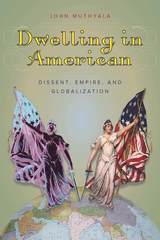
Dwelling in American
Dissent, Empire, and Globalization
John Muthyala
Dartmouth College Press, 2012
Globalization is not the Americanization of the world, argues John Muthyala. Rather, it is an uneven social, cultural, economic, and political process in which the policies and aspirations of powerful nation-states are entangled with the interests of other empires, nation-states, and communities. Dwelling in American: Dissent, Empire, and Globalization takes up a bold challenge, critiquing scholarship on American empire that views the United States as either an exceptional threat to the world or the only hope for the future. It does so in order to provincialize America, to understand it from outside the borders of nation and location, and from inside the global networks of trade, power, and culture. Using comparative frames of reference, the book makes its arguments by examining the work of a diverse range of writers including Arundhati Roy (War Talk, Power Politics), Azar Nafisi (Reading Lolita in Tehran), and Thomas Friedman (The World Is Flat). This is an original, complex, and often bracingly counterintuitive critique of the idea of American empire that will appeal to anyone interested in understanding the complexities of globalization.
[more]
READERS
Browse our collection.
PUBLISHERS
See BiblioVault's publisher services.
STUDENT SERVICES
Files for college accessibility offices.
UChicago Accessibility Resources
home | accessibility | search | about | contact us
BiblioVault ® 2001 - 2024
The University of Chicago Press









